Leading Skills Needed to Master Medical Administration Roles Today
Leading Skills Needed to Master Medical Administration Roles Today
Blog Article
Finest Practices in Medical Administration for Improving Performance and Lowering Expenses
In the ever-evolving landscape of health care, the pursuit of ideal techniques in medical administration is extremely important for improving effectiveness and suppressing costs. By integrating advanced modern technologies such as electronic wellness documents and telemedicine, healthcare companies can improve procedures and enhance patient treatment. However, modern technology alone is not a remedy; optimizing source allotment and cultivating collective communication amongst care groups are equally critical (medical administration). As companies strive to stabilize quality and expense, what approaches should be prioritized to accomplish these double goals? The solutions to these questions hold the secret to an extra sustainable health care system.
Leveraging Advanced Technology
In today's swiftly evolving health care landscape, leveraging innovative technology is no longer optional however crucial for reliable clinical administration. The combination of digital solutions into medical care systems has actually changed the means facilities operate, improving procedures and boosting person treatment. Electronic Wellness Records (EHRs) are crucial, giving comprehensive patient information that can be accessed instantly by authorized employees, hence lowering redundancy and decreasing mistakes. By systematizing individual info, EHRs get rid of the requirement for troublesome paperwork and facilitate seamless interaction amongst doctor.
Telemedicine is one more technological advancement that has actually reinvented patient communication. It uses comfort for both patients and medical care specialists by enabling remote appointments, which can decrease the demand for in-person check outs and maximize visit organizing. In addition, telehealth platforms can expand healthcare accessibility to country or underserved areas, connecting gaps in care delivery.
In addition, making use of Artificial Intelligence (AI) and artificial intelligence is coming to be increasingly common in anticipating analytics, permitting very early discovery of potential health issues and even more enlightened decision-making. These technologies, when integrated successfully, can boost analysis accuracy and personalize person treatment plans, ultimately causing boosted health care outcomes and operational effectiveness.
Optimizing Resource Allowance
By strategically managing sources such as employees, tools, and financial resources, health care centers can dramatically boost their functional performance, improve person end results, and minimize unnecessary expenditures. The first step in maximizing source allotment involves performing a thorough evaluation of current assets and recognizing locations where resources might be underutilized or overextended.
Prioritizing source allocation based on person needs and service needs is vital. This involves aligning sources with high-demand areas, such as emergency treatment or specialized treatments, to make certain prompt and effective patient treatment. Carrying out flexible staffing designs can additionally maximize labor resources by readjusting employees allowance in reaction to rising and fall client quantities. Furthermore, welcoming telemedicine and other technical solutions can relieve physical resource restraints by offering alternate avenues for patient-provider interactions.
Economic sources should be thoroughly monitored and assigned with calculated insight to sustain both short-term operational needs and lasting institutional objectives. This consists of investing in training programs that enhance staff proficiencies and embracing energy-efficient techniques that lower operational expenses (medical administration). Inevitably, a maximized source allocation strategy fosters a sustainable health care environment that is responsive, effective, and economically prudent
Streamlining Process Processes
When health care facilities objective to boost operational effectiveness, streamlining workflow procedures comes to be a pivotal emphasis. Effective operations reduce redundancy, get rid of unneeded actions, and improve sychronisation amongst medical care specialists. This technique not just speeds up service delivery yet additionally improves the high quality of client care.

Next, modern technology assimilation plays a significant duty in streamlining process. Implementing digital health and wellness documents (EHRs) and computerized doctor order access (CPOE) systems decreases documents, decreases human error, and makes certain information comes to all relevant personnel. Furthermore, leveraging telemedicine systems can streamline patient examinations and follow-ups, reducing the strain on physical facilities.

Eventually, streamlined process cause cost reductions and improved client fulfillment, cultivating a much more sustainable healthcare environment.
Enhancing Data Monitoring
Structure upon structured process, enhancing data administration ends up being a crucial element ahead of time healthcare management. Reliable data management systems are essential for preserving accurate patient documents, enhancing decision-making, and guaranteeing compliance with governing requirements. By executing robust information administration solutions, medical care centers can enhance the top quality of individual care while simultaneously reducing operational costs.
One trick element of enhancing information management is the integration of sophisticated electronic health and wellness record (EHR) systems. These systems assist in the seamless exchange of person info throughout different divisions, minimizing duplication of examinations and minimizing errors. A properly designed EHR system supports information analytics, allowing doctor to determine trends and make notified choices concerning client treatment.
Furthermore, guarding individual information is critical. Taking on extensive cybersecurity actions, consisting of file encryption and normal audits, guarantees the stability and discretion of sensitive details. This not just safeguards individuals yet additionally maintains the establishment's reputation.
Buying team training is an additional crucial aspect. Informing healthcare experts on information monitoring methods enhances their capacity to successfully make use of modern technology, causing improved patient outcomes. In verdict, boosting data monitoring with sophisticated modern technology and comprehensive training is important for achieving performance and expense decrease in medical administration.
Fostering Collaborative Interaction
An essential component ahead of time medical administration is cultivating collaborative interaction among medical care professionals. Reliable communication is paramount for making certain smooth patient treatment, enhancing treatment outcomes, and decreasing errors. By encouraging open discussion and control across multidisciplinary teams, health care companies can boost their operational effectiveness and reduce unneeded costs.
Central to this approach is the assimilation of interaction modern technologies such as electronic health records (EHRs) and safe messaging systems, which promote the fast exchange of essential client details. These tools enable doctor to access and share information in real time, guaranteeing that all group participants are educated and aligned in their decision-making weblink procedures. Moreover, normal team meetings and interdisciplinary rounds can further promote a society of partnership and accountability.
Training programs focused on improving communication abilities are additionally crucial. Ultimately, cultivating collective interaction leads to boosted healthcare distribution and cost savings.

Final Thought
Incorporating sophisticated modern technology, such as digital health documents and telemedicine, along with optimized resource allotment and structured operations processes, is crucial for boosting effectiveness in clinical management. Effective information administration and promoting collective communication among health care groups are essential for lessening redundancies and enhancing treatment top quality. By focusing on preventative care and participating in top quality improvement campaigns, health care organizations can attain considerable cost financial savings and boosted client end results, therefore making certain lasting health care distribution in a progressively complex setting.
Report this page